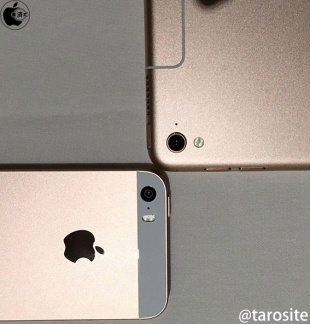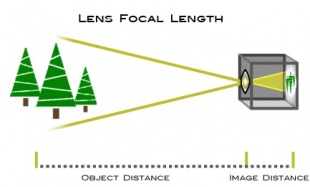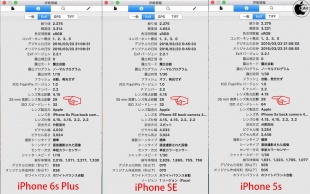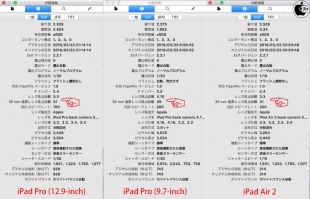iOSデバイスにおけるiSightカメラの出っ張りの有無は、フォーマットサイズ違いによる撮影画角差を少なくするため
※本サイトは、アフィリエイト広告および広告による収益を得て運営しています。購入により売上の一部が本サイトに還元されることがあります。
Appleが、iPhone SE、iPad Pro (9.7-inch)の製品説明会を行いました。
そこで、@taromatsumuraさんに「ƒ/2.4の開口部を持つiSightカメラは、iPod touch (6th generation)を除きカメラ部分は飛び出ず、ƒ/2.2の開口部を持つiSightカメラになると、厚さ7.6mmのiPhone SEではカメラ部分は飛び出ないのに、他の製品では飛び出る。これはなぜなのか?」と質問してもらいました。
Appleは「内部デザインと、端末自体の厚みによるもの」と回答したそうです。
この質問は、レンズが飛び出ている理由について聞く内容としては正しくありません。
Appleは、センサーサイズを明らかにしておらず、公開していない情報について質問した場合、ノーコメントになる可能性があるため、敢えてこうした聞き方となっています。
このレンズの出っ張りは、センサーサイズが異なることによるフォーマットの広さによって発生する撮影画角差を少なくするためだと考えられ、その回答として「厚さ」を上げている分けです。
同じ距離の被写体を撮影する場合、焦点距離が短いレンズは画角が広くなり、被写体は小さくなります(広角レンズ)、焦点距離が長いレンズは画角が狭くなり、被写体は大きくなります(望遠レンズ)
フォーマットサイズが大きくなると、カメラが写しこむ画像の範囲が広くなり、同じ距離の被写体は小さくなります。
つまり、フォーマットが大きくなり、被写体が小さくなるところを、望遠レンズで大きくし、撮影画角差を小さくしているわけです。
(参考サイト:ニコンイメージングの「焦点距離と画角」)
iPhone 5s、iPhone SEは厚みが7.6mmなのに対してiPhone 6s Plusは7.3mmと0.3mmの差があります。
センサーサイズは同じで、画素ピッチの小型化による高画素化の場合、焦点距離は変わりません。
つまり、レンズが飛び出ないためには、7.6mmの長さが必要となり、それが厚みということです。
iPad Pro (12.9-inch)、iPad Pro (9.7-inch)、iPad Air 2の写真にあるExif情報からレンズ焦点距離を確認してみます。
iPad Pro (12.9-inch)、iPad Air 2のレンズ焦点距離は3.3なのに対して、iPad Pro (9.7-inch)は、iPhone 6sなどと同じ4.15と表示されます。
このことから、iPad Pro (9.7-inch)のカメラセンサーは、iPhone 6s、iPhone SEと同じサイズに変わり、これまでのiPadに搭載されていたセンサーと比べて大きくなったことが読み取れます。
ゆえにiPad Pro (9.7-inch)のカメラは、6.1mmの厚さに納めることが出来ない焦点距離の長いレンズが必要となり飛び出ているわけです。
写真:@taromatsumura / @tarosite
Because having projection or not of the iSight camera in the iOS device reduces the photography angle of view difference by the format size difference
Apple held an iPhone and iPad product presentation.
"The iSight camera with the f/2.4 aperture protrudes on all iOS devices except for the iPod touch, and the iSight camera with the f/2.2 aperture doesn't protrude on the iPhone SE which is 7.6 mm thick but on other devices it does. Why is that so?" was asked.
Apple answered, "It depends on the internal design, and the thickness of the device itself."
This question is not correct if you want to know about the reason why the lens protrudes.
Apple has not made the sensor size clear, so when someone asks for an information that has not been disclosed, there is a high possibility that no comment will be given, and that is the reason why I deliberately put my question this way.
Focal length, usually represented in millimeters (mm), is the basic description of a photographic lens. It is not a measurement of the actual length of a lens, but a calculation of an optical distance from the point where light rays converge to form a sharp image of an object to the digital sensor or 35mm film at the focal plane in the camera. The focal length of a lens is determined when the lens is focused at infinity.
The focal length tells us the angle of view—how much of the scene will be captured—and the magnification—how large individual elements will be. The longer the focal length, the narrower the angle of view and the higher the magnification. The shorter the focal length, the wider the angle of view and the lower the magnification.
The portions where the subject becomes smaller (because of the larger format) are amplified with telephoto lens, reducing the difference in photograph angle of view.
Therefore, iPad Pro (9.7-inch) camera needs a lens with a long focal length, which does not fit in the thickness of 6.1mm and ends up protruding.















